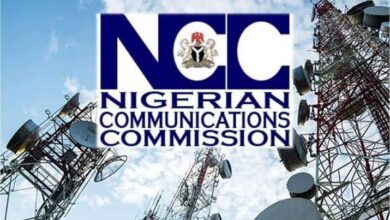OPINION: Internet Connectivity And Lessons From The Undersea Cable Cuts

When a fall back option becomes an option,there are issues to contend with.
Nigerian Communications Satellite(NIGCOMSAT 1) was launched on May 13,2007 and deorbited on November 11,2008 as a result of Solar array power failure and confined to the graveyard.
The consequences of the failure resulted in many companies which derived their services from it suffered setbacks.
Some banks that had the misfortune of taking their decisions to connect to NIGCOMSAT became laughing stocks by their contemporary banks who were believed to be wiser to ignore the marketing powers of Timasaniyu Ahmed Rufai and his team.
The failure of NiGCOMSAT was seen as a result of the “Nigerian factor” especially when the pioneer communications satellite in Africa had no backup and seen as one risk too many.
That was its only sin because across the globe satellites fail sometimes on the launch day in the process of launching.
Satellites launches are generally laced with anxieties because anything could happen in a split of seconds.
But NIGCOMSAT 1 was in the orbit for 18 months before it had its challenges.
While many organizations licked their wounds and scampered for alternatives,Nigerian government began new moves to relaunch another satellite.
At the beginning of the deal with China Great Wall Industry Corporation (CGWIC),part of the agreement was that China through the China Exim Bank was going to fund the project and to be managed by the Chinese at the ground station in Xichang for two years before handing over to Nigeria.
Its ownership by Nigeria was strictly through counterpart funding for which Nigeria contributed $50m at that time.CGWIC paid $200m.
After all the bashings on the Nigerian Communications Satellite Limited and its management,a new satellite,
NIGCOMSAT 1R was launched on December 19,2011.
But the excitement was no longer there and as the satellite with its 15-year lifespan begins its last journey,its owners and management have very little to celebrate.
And the crisis of the undersea cable cuts on Thursday March 14,2024 opened a new reality in internet connectivity and reopened the NIGCOMSAT story..The cuts took place around Cote D Ivoire and Senegalese axis.
Those millions of organizations who relied heavily on this almost foolproof technology of connectivity were jolted by the cuts as they experienced downtime that affected their businesses.
Banks and other corporate organizations that believed in the services from these undersea cables in Africa and especially in West Africa had their plans scuttled as they began to review all the options available for seamless communication access to run their networks of branches that depended solely on the undersea cables.
The danger of the cut was that the banks especially had no alternatives as the undersea cables had no back ups.
Telecommunications companies were also badly hit as they depended on the undersea cables to run their services including terrestrial and mobile phone communications.
Skeletal services for voice connections were available since the Mobile Switching Centres(MSCs) and base stations were still up.
Internet connectivity for corporate organizations and individuals wwere however badly disrupted and as the companies battle to redress the situation,full service restoration which were anticipated to take a while were said to have been restored as at Monday March 18,2024.
There are therefore lessons to be learnt.
Are undersea cables the answer to seamless communications or can we in all honesty completely disregard communication satellites simply because of the failure of one satellite and conclude that satellite is not it?
In the light of the crisis from the cable cuts it is fair to conclude that satellite communications is as good as undersea cables connectivity. The only problem with NIGCOMSAT was that it had no back up.
It stands to reason that Undersea cables connectivity could be likened to one-way traffic. If they fail that is it as there are no backups too and downtime is severe and may last for days if not weeks. But we must admit that Undersea cables are critical infrastructure for internet connectivity, carrying vast amounts of data traffic across continents. However, they are susceptible to damage, including accidental cuts, natural disasters, or technical malfunctions.
Disruptions to these cables can significantly impact businesses, government operations, and individual users.
This is not the first time a subsea cable will get damaged in the region. In 2023 alone ,two submarine cable systems, which also service the Nigerian market, suffered damage off the coast of West Africa.
According to agency reports,the West African Cable System (WACS) and the South Atlantic 3 (SAT-3) undersea cables suffered breaks between the Democratic Republic of Congo and Cameroon due to two separate rock falls in the Congo Canyon.
In 2020, WACS suffered cuts, slowing down Internet services in the country.
On its X handle, MTN Nigeria, one of the affected providers, apologised to its subscribers. “Our engineers are working to resolve these challenges as soon as possible…”
Recently, multiple fibre cuts shut out MTN Nigeria subscribers from making calls and browsing the Internet for several hours.
An official at MTN Nigeria, said, “Our customers have been experiencing challenges connecting to the network due to a major service outage caused by multiple fibre cuts, affecting voice and data services.”
Mainone ,an infrastructure company said in a statement on its website that it became necessary to declare a force majeure subsequent to testing of its cable system.
It said that data from the preliminary assessment of the cable system indicated some underwater activity was the likely cause of disruptions to the system.
It said that commercial contracts typically included such a force majeure clause which enabled service providers to suspend contractual obligations for the duration of such disruptions.
A force majeure is an unforeseeable circumstance that prevents someone from fulfilling a contract.
The unforeseen circumstances maybe natural disasters (fire, storms, floods), or governmental or societal actions (war, invasion, civil unrest, labour strikes), or infrastructure failures (transportation, energy).
“Live network data show a major disruption to Internet connectivity in and around West and Central Africa,” Internet monitoring firm NetBlocks said .
MyBroadband reports the downtime was caused by multiple outages on undersea cables near Abidjan in Côte d’Ivoire.
The SAT-3/West Africa Cable System (WACS), the Africa Coast to Europe (ACE), and other cables were affected. The outage started around 12:30 on Thursday, March 14,2024.
“Multiple undersea cable failures between South Africa and Europe currently impacting South Africa’s network providers, including Vodacom,” a Vodacom spokesperson explained in a statement.
Doug Madory, director of Internet analysis at Kentik, indicated there were also issues with the MainOne subsea cable.
Microsoft is reporting network latency issues in its South Africa North and South Africa West locations.
“Starting at 10:30 UTC on Mar 14,2024, customers using Azure Services in South Africa North and South Africa West experienced increased network latency or packet drops when accessing their resources,” the company said.
“We have determined that multiple fiber cables on the West Coast of Africa — WACS, MainOne, SAT3, ACE — have been impacted which reduced total capacity supporting our Regions in South Africa,” Microsoft said in an update. “In addition to these cable impacts, the on-going cable cuts in the Red Sea — EIG, Seacom, AAE-1 — are also impacting capacity on the East Coast of Africa. This combination of incidents has impacted all Africa capacity – including other Cloud providers and public Internet as well.”
Interestingly, this is not the first time damage to undersea cables have caused internet disruptions, in 2020, MTN blamed undersea cables for Internet disruptions in West Africa.
In 2018, 10 West African countries were completely offline for 48 hours, due to damages to the African Coast to Europe (ACE) submarine cable.
MainOne’s 14,000 km submarine cable system also disrupted the Internet in 2017 across West Africa. This time, however, Internet troubles seem to go beyond Africa to some European countries, which could mean a more severe problem this time.
Telecommunications companies and banks in Nigeria were on that Thursday March 14,2024 hit by an internet outage as a result of damage to international undersea cables supplying them connectivity.
Industry regulator, Nigerian Communication Commission (NCC), explained that the damage affected major undersea cables near Abidjan in Côte d’Ivoire causing downtime across West and South African countries.
Sensing the danger of not having a backup option,many organizations have had to take the satellite Communications routes .
Strong satellite companies offering services include SES S.A. established in 1985 and located in Betzdorf, Luxembourg.
Viasst Inc another company was established in 1986 and with headquarters in California, United States.
There are also Intelsat established in 1964 and believed to be the largest and located in Virginia, United States.
Tele sat based in Canada was established 1969.
There are also General Dynamics (1952)
in New York, United States and Gilat satellite network ,Echostar, Inmarsat and Eutelsat among others.






